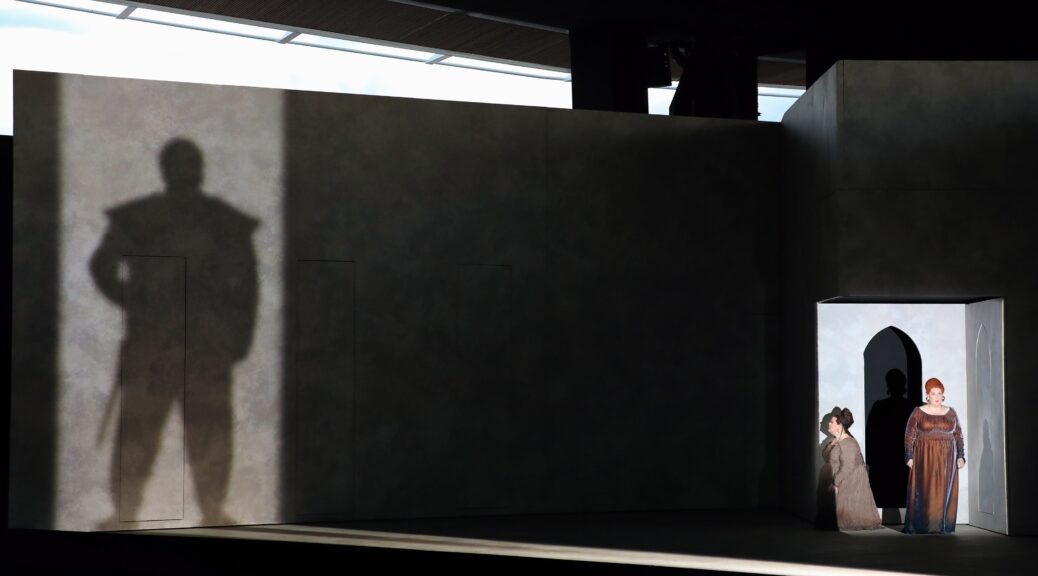
ISOLDE’S TRIUMPH
SANTA FE, NM—–A dawdling Mark Twain said it best, tongue-in-cheek, when late to a lecture in German: “We’ll get there in time for the verb” (which comes at the end).
The Santa Fe Opera made a grand and memorable stab at its first oversize opera ever, Wagner’s “Tristan und Isolde,” a huge work for huge voices few thought ever possible in this indoor-outdoor theater with scant flies lacking elaborate stage machinery and giant orchestra pit while projecting the opera world’s grandest and slowest-moving love story of all over four and a half hours.
The romantic work based on very early European sources embodies concepts of the eminent German philosopher Arthur Schopenhauer, that the ultimate experience of enamored couples comes in love-death, voiced in unforgettable terms during the eulogy for the lover by the grieving Isolde. Though their love had been illicit, that’s understandable, as the composer himself had been through similar episodes himself and felt he could be broad-minded.
In this medieval tale, King Marke’s trusted knight Tristan was to bring the fair Isolde as the bride-to-be of the king. All of Isolde’s earlier resentments of Tristan are rapidly removed when she drinks a magic potion making her fall passionately in love with the knight during a ship passage. The arriving king finds to his horror the two locked in an embrace, whereupon a courtier deals Tristan a near-fatal blow. The ailing Tristan is shipped back to his old home to die by the shore. Still yearning for Isolde, he dies moments before her arrival, leaving her to deliver the opera’s famous Liebestod eulogy.
One of the colossal new Wagnerian voices has come out of a less likely site: Houston, Texas. Take nothing away from soprano Tamara Wilson’s Isolde: It was breathtaking in its scope and grandeur, filling the high prairies all around with her fine German and striking acting ability. This marked her Isolde debut.
Conciseness was never Wagner’s strong suit—-wordiness was thought wonderful. When Marke catches the lovers in an inappropriate position, he is deeply hurt, and spends 15 minutes telling every one just how hurt he is. And when Tristan dies, Isolde doesn’t deliver her great eulogy until others arrive and interact, where some are knifed and others get killed, as if Wagner hadn’t decided yet just how to end it.
The sets for this grand production consisted of blank walls which, when properly folded, would make the biggest Amazon shipping carton of all time, some 18 ft. high. There is no Tristan ship, nor any shore where he dies. The director team of Winokur and Castañón countered the barrenness with shadow projections of principals, at times even a hallucination of a ghostly Isolde. One was less impressed by the handling of the love scenes, looking too much like very large animals rolling about trying to mate. But opera-goers long ago decided that what you hear greatly outweighs what you see.
You could not expect 106 musicians playing in the pit, as in that hallowed Wagner site at Bayreuth, Germany. But Santa Fe did manage 73, playing gamely for the ex-Bay Area conductor James Gaffigan. The somber second half was full of lovely English horn solos by Julia DeRosa.
I won’t say much about the Tristan of miscast tenor Simon O’Neill, whose grainy voice did not open up till three hours into the show. But the supporting cast was supernal: Nicholas Brownlee (Kurwenal), Jamie Barton (Brangane), and bass Eric Owens (King Marke).
Some cuts were made to bring the length down to four and a half hours.
Having resumed after pandemic shutdowns, this summer-season troupe founded in 1957 appears to have taken off anew with full operations and gusto.
WAGNER’S ‘TRISTAN UND ISOLDE,’ in German, at the Santa Fe Opera, New Mexico, heard in German Aug. 11, repeating Aug. 19, 23. For info: (505) 986-5900, or online at www.santafeopera.org.